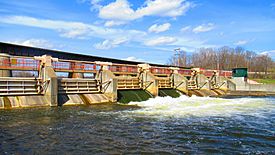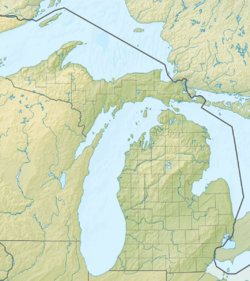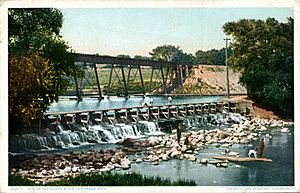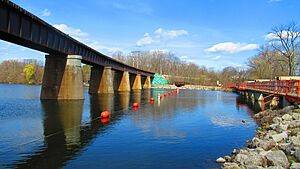Argo Dam facts for kids
Quick facts for kids Argo Dam |
|
|---|---|

Argo Dam in April 2020
|
|
|
Location within the state Michigan
|
|
| Location | Huron River Ann Arbor, Michigan |
| Coordinates | 42°17′26″N 83°44′45″W / 42.29056°N 83.74583°W |
| Purpose | Power |
| Status | Decommissioned |
| Opening date | 1920 |
| Owner(s) | City of Ann Arbor |
| Dam and spillways | |
| Type of dam | Barrage |
| Impounds | Huron River |
| Height | 18 feet (5.5 m) |
| Length | 150 feet (45.7 m) |
| Width (crest) | 162.5 feet (49.5 m) |
| Spillway capacity | 8,500 ft3/s (240.7 m3/s) |
| Reservoir | |
| Total capacity | 92 acres (37.2 ha) |
The Argo Dam is a large wall built across the Huron River in Ann Arbor, Michigan. It was first built in 1920 to make electricity from water power. This is called hydroelectric power.
Later, in 1959, the dam stopped making electricity. In 1963, the city of Ann Arbor bought it. Today, the area around the dam is a popular spot for fun outdoor activities. You can find parks like Argo Nature Area and Bandemer Park nearby.
Contents
What is the Argo Dam?
The Argo Dam is in the northern part of Ann Arbor. It's about 0.75 miles (1.21 km) south of the M-14 highway. The dam is about 50.5 miles (81.3 km) from where the Huron River flows into Lake Erie.
When the dam was finished, it created a large pool of water. This pool covers about 96 acres (39 ha). It doesn't have an official name, but people often call it the Argo Pond. The water in the pond is about 16.3 feet (5.0 m) deep on average. The pond stretches for about 2.46 miles (3.96 km) upstream. It's mostly a natural area with no big changes to the land around it.
The dam itself has six gates called spillways. These gates help control the water flow. The dam is 18 feet (5.5 m) tall. It can release a lot of water, up to 8,500 cubic feet (240.7 m3) per second.
The city of Ann Arbor owns four dams, and Argo Dam is one of them. The other dams are Barton Dam, Geddes Dam, and Superior Dam. Only Argo Dam and Barton Dam are actually inside the city limits.
History of the Dam
People have been building dams on this part of the Huron River since the 1830s. The current Argo Dam was completed in 1920. It was part of a group of hydroelectric dams built by the Detroit Edison Company. These dams helped make electricity for the area.
In 1959, the Argo Dam stopped making electricity. The city of Ann Arbor bought it in 1963. The dam was rebuilt in 1972. After that, its main jobs were to keep the water level steady in the pond and help control floods.
The Detroit Edison Company used to run four hydroelectric dams near Ann Arbor. These were Argo Dam, Barton Dam, Geddes Dam, and Superior Dam. By the early 1960s, they all stopped making electricity. However, Barton Dam and Superior Dam were later fixed up in the 1980s. They still make hydroelectricity for Ann Arbor today. Argo Dam and Geddes Dam were not fixed up because it would have cost too much money.
Around 2008, there was an idea to start making electricity at Argo Dam and Geddes Dam again. The goal was to power a nearby hospital. But a report in 2010 showed it would cost a lot of money, about $14.7 million, to build new power stations. Because of the high cost, the plan was not approved. The city decided to improve the areas around the dams instead. In 2014, the Argo Dam area got some big improvements, but the idea of making electricity there was stopped.
Should the Dam be Removed?
Since the dam was too expensive to use for electricity again, people started talking about removing it completely.
Some people thought removing the dam would be good for the environment. It could make the Huron River's water temperature more natural. It would also let the river flow more freely for about 6 miles (9.7 km). This could help fish populations grow. The slow-moving water in the pond also has many zebra mussels, which are not native. Removing the dam would make the water flow faster and reduce these mussels. Removing the dam might also create more park land along the river. It could also make it easier for kayakers to travel further.
However, others disagreed. They worried that lowering the water level would create a muddy area that would take a long time to become useful land. They also said there was no proof that removing the dam would help fish populations. The pond is also used by the University of Michigan women's rowing team and high school teams for practice. In 2010, the state allowed the city to keep the dam. The dam was in good shape and did not need repairs, so it stayed.
Fun Things to Do at Argo Dam
The land around the Argo Dam pond is owned by the city. It includes two city parks. The Argo Nature Area is on the east side, covering 22 acres (8.9 ha). Bandemer Park is on the west side, covering 36.9 acres (14.9 ha).
The Border-to-Border Trail also crosses the Argo Dam. This trail is 35 miles (56 km) long and is great for walking or biking.
The Argo Dam pond is a very popular place for kayaking and canoeing on the Huron River. The city even has a place called the Argo Pond Livery where you can rent kayaks and canoes. In 2012, the city built the artificial Argo Cascades. These are like small waterfalls that let kayakers go around the dam easily. The water drops 12 feet (3.7 m) over 1,200 feet (370 m). This means kayakers don't have to carry their boats around the dam anymore.
When the Argo Dam was rebuilt in 1972, all the fish were removed from this part of the river. After the dam was finished, the Argo Dam pond was filled with new fish. These included smallmouth bass, walleye, and rainbow trout. Later, Channel catfish were also added. Today, you can still go fishing from the shore in the pond or downstream. You might catch channel catfish, bluegill, bass, black crappie, northern pike, and walleye.
Staying Safe in the Water
Sometimes, the Michigan Department of Health and Human Services tells people not to eat fish from the Huron River. This happens when there are high levels of certain substances in the water. When this warning is in place, it's best not to spend too much time in the water. Fishermen are advised to catch and release their fish. Signs are put up at river access points to warn people. This warning often includes the Argo Dam part of the river.
See Also





